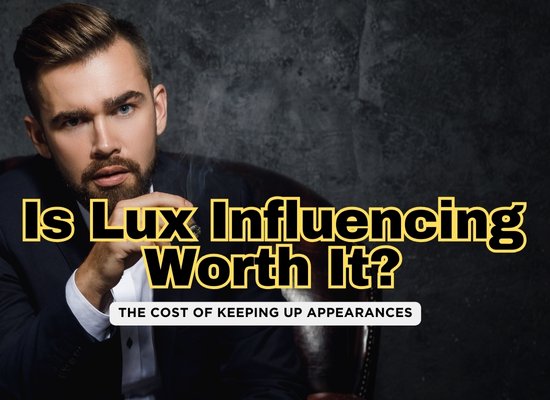Living the Dream… or Just an Illusion?
On the surface, the life of a luxury influencer looks like a dream. Exotic vacations, designer outfits, high-end dining, and an endless stream of luxury experiences—all documented and shared for thousands, sometimes millions, of followers. But behind the flawless Instagram posts and aspirational YouTube vlogs, there’s another side to this lifestyle that many don’t see.
Luxury influencers face pressures, expectations, and personal challenges that can make their glamorous world feel more like a carefully constructed illusion than reality. Here are eight downsides to the luxury influencer lifestyle that most people don’t think about.
1️⃣ The Constant Pressure to Maintain an Image
Luxury influencers aren’t just documenting their lives—they are curating a brand. Their audience expects a constant stream of high-end experiences, which means there’s little room for showing anything that doesn’t fit the glamorous image.
This pressure can lead influencers to:
- Overspend to keep up appearances, even when finances are tight.
- Accept sponsorships for luxury products they don’t truly love just to maintain the image.
- Avoid sharing personal struggles or real-life challenges for fear of breaking the illusion.
For many influencers, the pressure to always look wealthy and successful can be exhausting. Even when money is coming in, the lifestyle can feel like a performance that never stops.
2️⃣ The Financial Burden of Keeping Up
While some luxury influencers genuinely earn high incomes, many struggle to maintain the expensive lifestyle they portray. Sponsorships and affiliate deals don’t always cover the full cost of luxury trips, designer wardrobes, and exclusive events.
Common financial traps include:
- Renting designer items, cars, or luxury Airbnb stays just for content.
- Taking on debt to afford the next big experience or brand deal.
- Spending more than they earn in an effort to keep up with competitors in the industry.
For those who don’t have generational wealth or steady brand partnerships, the financial burden of staying relevant can quickly spiral out of control. The illusion of effortless wealth often hides the reality of budgeting, strategic spending, and even financial stress.
3️⃣ The Emotional Toll of Always Being “On”
Luxury influencers are not just people—they are brands. Their income and relevance depend on their ability to engage with their audience constantly. That means their personal life is intertwined with their content, leaving little room for genuine downtime.
Some of the emotional challenges include:
- Feeling like they can never take a break without losing engagement.
- Experiencing burnout from constantly creating and curating content.
- Dealing with imposter syndrome, wondering if they really belong in the world they portray.
Even seemingly simple things—like enjoying a vacation—become work. Instead of relaxing, influencers have to think about getting the perfect shot, keeping their audience engaged, and negotiating brand deals while on the go. Over time, this can lead to stress, anxiety, and a feeling of being trapped in their own persona.
4️⃣ The Loss of Privacy
Luxury influencers thrive on sharing their lives, but that exposure comes at a cost. Unlike traditional celebrities who may have periods of separation from the public, influencers are expected to be accessible at all times.
Privacy issues can include:
- Fans and followers feeling entitled to know every detail about their lives.
- Personal locations being tracked through social media posts, leading to safety concerns.
- Difficulty in maintaining personal relationships as everything is under public scrutiny.
Even when influencers try to set boundaries, the nature of their career makes it difficult to separate personal moments from public content. As their audience grows, so does the feeling of being watched—sometimes in ways that go far beyond social media.
5️⃣ The Instability of the Industry
Unlike traditional careers, luxury influencing has no guaranteed income, no job security, and no clear career trajectory. The digital landscape changes rapidly, and what works today might be irrelevant tomorrow.
Some major risks include:
- Social media algorithms shifting, leading to a sudden drop in engagement and earnings.
- Brand deals drying up if a luxury brand changes its marketing strategy.
- Oversaturation in the industry, making it harder to stand out as new influencers enter the space.
Many influencers go from making six figures in brand partnerships to struggling to secure collaborations within a year. Because the industry is still evolving, there is no clear blueprint for long-term success, leaving many influencers unsure of how to maintain their lifestyle beyond a few peak years.
6️⃣ The Challenge of Staying Relevant
In the world of luxury influencing, attention is currency. Once an influencer starts losing engagement, it becomes harder to secure brand deals and maintain their income. To stay in the game, they have to constantly reinvent themselves while competing with newer, younger, or more extravagant influencers.
This leads to:
- Pressure to create increasingly extreme or over-the-top content just to keep audience interest.
- Needing to adapt to every new platform or trend, whether it’s TikTok, AI-generated content, or virtual experiences.
- Fear of becoming “old news” in an industry that prioritizes fresh faces and new voices.
Many influencers find themselves in a cycle of chasing engagement, only to burn out or lose their audience when they can no longer keep up. Even those who successfully stay relevant have to work harder each year to maintain their place in an ever-changing market.
7️⃣ Ethical Dilemmas of Promoting Wealth Culture
Luxury influencers thrive on selling a lifestyle of wealth, exclusivity, and success. But this creates a dilemma—are they inspiring their audience or contributing to unrealistic standards?
Some ethical concerns include:
- Promoting luxury consumption as an aspirational goal, even when it leads followers into debt or financial strain.
- Endorsing products or services they don’t truly use just because of lucrative brand deals.
- Showcasing extravagant experiences while ignoring the larger economic and environmental impact of excessive consumption.
Many influencers struggle with the balance between authenticity and maintaining their income. Some genuinely enjoy the lifestyle they promote, while others feel trapped in a cycle of selling an image they no longer resonate with.
8️⃣ The Personal Sacrifices Behind the Glamour
Luxury influencers may have access to designer clothes, private jets, and five-star hotels, but these perks often come at a cost to their personal lives. Many find themselves sacrificing genuine relationships, personal growth, and even mental health to sustain their brand.
Some of the most common sacrifices include:
- Losing friendships and relationships as their career demands more time and curated interactions.
- Struggling with self-worth when their value becomes tied to external validation from followers and brands.
- Feeling unable to return to a “normal” life if the influencer career fades, as their identity has been built around luxury.
For some, the trade-offs are worth it. But for others, the toll on personal happiness and well-being becomes too great, leading them to step away from the industry entirely.
The luxury influencer lifestyle may seem like a dream, but the reality is far more complicated. While some thrive in this space, many find themselves caught in a cycle of financial pressure, emotional exhaustion, and the constant need to stay relevant.
For aspiring influencers, it’s essential to understand that luxury content is often an illusion—a carefully constructed narrative that doesn’t always reflect reality. While there are benefits to success in this industry, the challenges behind the scenes can make it far less glamorous than it appears.
The luxury lifestyle might look effortless, but for those living it, the cost can be higher than any designer handbag or first-class ticket.


